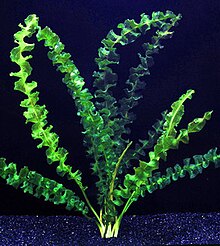Aponogeton capuronii
This article does not cite any sources. (May 2012) |
| Aponogeton capuronii | |
|---|---|

| |
| Scientific classification | |
| Kingdom: | Plantae |
| Clade: | Tracheophytes |
| Clade: | Angiosperms |
| Clade: | Monocots |
| Order: | Alismatales |
| Family: | Aponogetonaceae |
| Genus: | Aponogeton |
| Species: | A. capuronii
|
| Binomial name | |
| Aponogeton capuronii | |
Aponogeton capuronii (named after René Paul Raymond Capuron) is an aquatic plant found in southeastern Madagascar.
Description[]
Aponogeton capuronii has a rhizome up to 10 x 2-cm thick. Leaf blade 7–20 cm long petiolate, slightly leathery, 20–40 cm long and 3-4.5(-8) cm wide, flat or highly bullate and undulate, dark olive-green coloring. Apex acute, base round, cuneate or slightly cordate. Peduncle 40-60(-300) cm long, swollen toward the inflorescence. Spathe up to 1.5 cm long, caducous. Inflorescence with 2, seldom 3 up to 14 cm long spikes with omnilateral flowers; 2 white tepals; 6 stamens; 3-4 carpels with 2(-4) ovules each. Fruit about 6x3 mm in size, with a terminal beak. Seeds up to 3.25 x 1.5 mm in size, simple testa (van Bruggen, 1985).
Culture[]
A decorative Aponogeton, though with limited adaptability to living conditions in the aquarium. It was imported on a few occasions, but successful cultivation was the exception. A specimen featuring bullate leaf blades has been cultivated successfully for more than 20 years by in the Botanical Gardens Munich. The plant is kept in soft, weak acid water in a shaded location. According to this data, Aponogeton capuronii does not require a specific rest phase.
Ecology[]
The species grows in rivers with fast-flowing water. In February 1968, Bogner discovered plants in the (Madagascar) in a depth of 20–30 cm. When the author visited this location in December 1986, the river had a water level of nearly 2 m. The plants had hardly any juvenile leaves, which hinted at limited growth activity. Water values of this location were as follows: temperature 27.3 °C (air 30 °C at 13:30 h), pH 6.0, GH/KH < 1 °dH, Fe2+ = 0.05 mg/1, NOj not detectable. The substrate consisted of sand and gravel mixed with coarse, yellow clay.
Other[]
Forms specific to some locations and featuring bullate, undulate and flat blades have been identified.
References[]
- Aponogeton
- Plants described in 1968
- Flora of Madagascar
- Freshwater plants